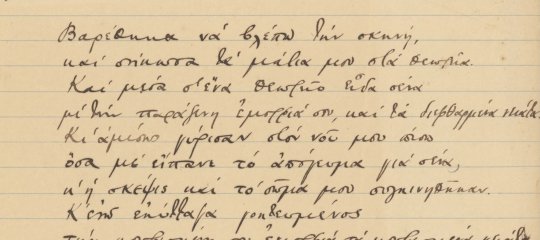Το ρήμα της νέας ελληνικής - Πίνακες
Το ΝΕ Ρήμα
Με αφορμή τους πίνακες του ΝΕ ρήματος της συναδέλφου Αρετής Πότσιου θα ήθελα να προτείνω κάποιους εναλλακτικούς -μορφολογικού1 κυρίως χαρακτήρα - πίνακες που περιγράφουν τη δομή του νεοελληνικού ρήματος με κάπως πιο «οικονομικό» τρόπο.
|
ΕΝΕΡΓΗΤΙΚΗ ΦΩΝΗ |
|||||
|
|
ΟΡΙΣΤΙΚΗ |
ΠΡΟΣΤΑΚΤΙΚΗ |
ΜΕΤΟΧΗ |
||
|
Θέμα: |
ΑΡΚΤΙΚΟ |
ΠΑΡΑΓΟΜΕΝΟ |
|
|
|
|
ΕΝ |
(θα, να, ας) λύνω |
(θα, να, ας) έλυνα |
λύνε |
λύνοντας |
|
|
ΑΟΡ |
(θα, να, ας) (λύσω)2 |
(θα, να, ας) έλυσα |
λύσε |
|
|
|
ΠΑΡΚ |
(θα, να, ας) έχω λύσει έχω λυμένο |
(θα, να, ας) είχα λύσει είχα λυμένο |
έχε λύσει έχε λυμένο |
έχοντας λύσει έχοντας λυμένο |
|
|
ΜΕΣΟΠΑΘΗΤΙΚΗ ΦΩΝΗ |
||||
|
|
ΟΡΙΣΤΙΚΗ |
ΠΡΟΣΤΑΚΤΙΚΗ |
ΜΕΤΟΧΗ |
|
|
Θέμα: |
ΑΡΚΤΙΚΟ |
ΠΑΡΑΓΟΜΕΝΟ |
|
|
|
ΕΝ |
(θα, να, ας) λύνομαι |
(θα, να, ας) λυνόμουν |
|
λυ(ν)όμενος |
|
ΑΟΡ |
(θα, να, ας) (λυθώ) |
(θα, να, ας) λύθηκα |
λύσου |
λυμένος3 |
|
ΠΑΡΚ |
(θα, να, ας) έχω λυθεί είμαι λυμένος |
(θα, να, ας) είχα λυθεί ήμουν λυμένος |
έχε λυθεί
|
έχοντας λυθεί όντας λυμένος |
Για τα ρήματα που δεν παρουσιάζουν αντίθεση ανάμεσα στο ενεστωτικό και το αοριστικό θέμα μπορούμε να έχουμε τις εξής δομές ανάλογα με το εάν η μη ύπαρξη της αντίθεσης οφείλεται:
- σε μορφολογική σύμπτωση των δύο τύπων:
|
|
ΟΡΙΣΤΙΚΗ |
ΠΡΟΣΤΑΚΤΙΚΗ |
ΜΕΤΟΧΗ |
||
|
Θέμα: |
ΑΡΚΤΙΚΟ |
ΠΑΡΑΓΟΜΕΝΟ |
|
|
|
|
ΕΝ- ΑΟΡ |
(θα, να, ας) κάνω |
(θα, να, ας) έκανα |
κάνε |
κάνοντας |
|
|
ΠΑΡΚ |
(θα, να, ας) έχω κάνει
|
(θα, να, ας) είχα κάνει
|
έχε κάνει
|
έχοντας κάνει |
|
- σε «σημασιολογικούς(?)» λόγους:
|
ΕΝΕΡΓΗΤΙΚΗ ΦΩΝΗ |
|||||
|
|
ΟΡΙΣΤΙΚΗ |
ΠΡΟΣΤΑΚΤΙΚΗ |
ΜΕΤΟΧΗ |
||
|
Θέμα: |
ΑΡΚΤΙΚΟ |
ΠΑΡΑΓΟΜΕΝΟ |
|
|
|
|
ΕΝ |
(θα, να, ας) έχω |
(θα, να, ας) είχα |
έχε |
έχοντας |
|
Ένας πιο πλήρης -και πιο «σημασιολογικός» - πίνακας του ελληνικού ρήματος που παίρνει υπ' όψη του όλους τους δυνατούς συνδυασμούς με τα μόρια θα, να, ας, θα μπορούσε να είναι ο εξής:
|
|
ΕΝΕΡΓΗΤΙΚΗ ΦΩΝΗ |
|
|||||||||||
|
ΘΕΜΑ |
Ενεστώτα |
Παρατατικού |
Αορίστου (αρκτικό) |
Αορίστου (παραγόμεν) |
Παρακειμένου |
Υπερσυντελίκου |
|||||||
|
Οριστική |
λύνω |
έλυνα |
|
έλυσα |
έχω λύσει |
είχα λύσει |
|||||||
|
Μέλλοντας- Δυνητική |
θα λύνω |
θα έλυνα |
θα λύσω |
θα έλυσα |
θα έχω λύσει |
θα είχα λύσει |
|||||||
|
Υποτακτική |
να λύνω |
να έλυνα |
να λύσω |
να έλυσα |
να έχω λύσει |
να είχα λύσει |
|||||||
|
Ευχετική |
ας λύνω |
ας έλυνα |
ας λύσω |
ας έλυσα |
ας έχω λύσει |
ας είχα λύσει |
|||||||
|
Προστακτική |
λύνε |
|
λύσε |
|
έχε λύσει |
|
|||||||
|
Μετοχή |
λύνοντας |
|
|
|
έχοντας λύσει |
|
|||||||
Αυτά., με την ελπίδα ότι οι πίνακες αυτοί μπορούν να διευκολύνουν τη δουλειά μας.
Γεωργία Κατσέλου εκ Σόφιας
1 Αν και ο πίνακας θέλει να είναι μορφολογικού χαρακτήρα, δεν είναι δυνατόν να αποφύγουμε τη χρήση σημασιολογικών όρων στις ονομασίες των διαφόρων κατηγοριών (π.χ. οριστική, προστακτική κ.λ.π.).
2 Ο αρκτικός τύπος του αοριστικού θέματος τίθεται σε παρένθεση γιατί δεν εμφανίζεται ποτέ μόνος του στο λόγο. Χωρίς τα μόρια θα, να, ας ή τους συνδέσμους εάν, όταν κ.λ.π. μπορεί να χρησιμοποιηθεί μόνο σε επανάληψη με ή χωρίς την άρνηση π.χ. έλθει δεν έλθει, βρέξει χιονίσει.
3 Για λόγους «συμμετρίας», και όχι μόνο, βάζω τη μετοχή «παρακειμένου» στη στήλη του αοριστικού θέματος: αυτή η μετοχή, αν και προέρχεται από την αρχαία μετοχή παρακειμένου, σχηματίζεται στα νέα ελληνικά από θέμα αορίστου μεσοπαθητικής διάθεσης ή φωνής π.χ. πεθαμένος.
- Πίνακες /










